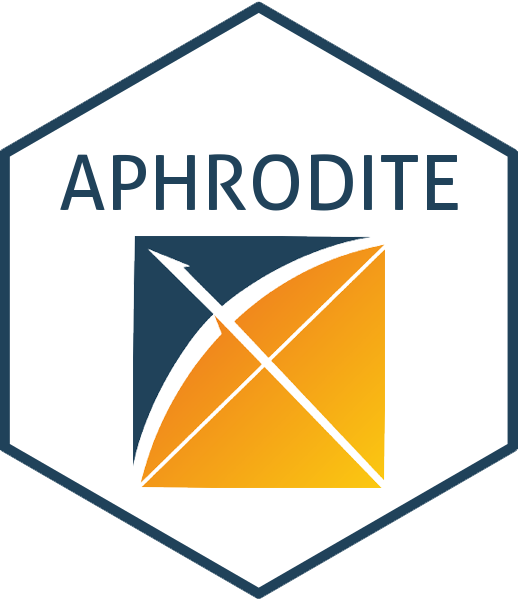Reference: http://www.ncbi.nlm.nih.gov/pubmed/27174893
Want to cite APHRODITE? Please cite this paper: https://www.ncbi.nlm.nih.gov/pubmed/28815104
How to video: http://tinyurl.com/use-aphrodite
- CDM v5
- R Packages:
- caret
- shiny
- dplyr
- pROC
- data.table
- devtools
- SqlRender
- DatabaseConnector
install_github("ohdsi/Aphrodite")
library(Aphrodite)
You need to update the /R/settings.R file with your CDM connection information and Phenotyping settings. Example runs for Myocardial Infarction
Aphrodite was developed using R version 3.1.2. Fully tested with CDMv5 and Vocabulary V5 on a Postgres DB server.
This file is also found under /samples/complete_example.R
library(Aphrodite)
library(SqlRender)
library(plyr)
library(caret)
library(pROC)
library(data.table)
library(DatabaseConnector)
library(ggplot2)
# Initiate connection to DB
#jdbcDrivers <<- new.env() #In case you get a connection error uncomment this line
folder = "/home/jmbanda/OHDSI/Aphrodite-TEMP/" # Folder containing the R files and outputs, use forward slashes
setwd(folder)
source("CopyOfsettings.R") #Load your settings.R - usually found in ../R/settings.R - Don't forget to edit it
connectionDetails <- createConnectionDetails(dbms=dbms, server=server, user=user, password=pw, schema=cdmSchema, port=port)
conn <- connect(connectionDetails)
##################################################################################
### STEP 1 - Generate Keywords ###
##################################################################################
wordLists <- buildKeywordList(conn, aphrodite_concept_name, cdmSchema, dbms)
write.table(wordLists$keywordlist_ALL, file=paste('keywordlistAF.tsv',sep=''), quote=FALSE, sep='\t', row.names = FALSE, col.names = FALSE)
write.table(wordLists$ignorelist_ALL, file=paste('ignorelistAF.tsv',sep=''), quote=FALSE, sep='\t', row.names = FALSE, col.names = FALSE)
message(paste("Keywords.tsv and ignore.tsv have been successfully created for ",aphrodite_concept_name,sep = ""))
##################################################################################
### NOTICE: Do not forget to edit the keywords and ignore files ###
##################################################################################
# Load Keyword list after editing
keywordList_FF <- read.table('keywordlistAF.tsv', sep="\t", header=FALSE)
ignoreList_FF <- read.table('ignorelistAF.tsv', sep="\t", header=FALSE)
##################################################################################
### STEP 2 - Look for cases and controls in the patient data ###
##################################################################################
casesANDcontrolspatient_ids_df<- getdPatientCohort(conn, dbms,as.character(keywordList_FF$V3),as.character(ignoreList_FF$V3), cdmSchema,nCases,nControls)
if (nCases > nrow(casesANDcontrolspatient_ids_df[[1]])) {
message("Not enough patients to get the number of cases specified")
stop
} else {
if (nCases > nrow(casesANDcontrolspatient_ids_df[[2]])) {
message("Not enough patients to get the number of controls specified")
stop
}
}
cases<- casesANDcontrolspatient_ids_df[[1]][sample(nrow(casesANDcontrolspatient_ids_df[[1]]), nCases), ]
controls<- casesANDcontrolspatient_ids_df[[2]][sample(nrow(casesANDcontrolspatient_ids_df[[2]]), nControls), ]
if (saveALLresults) {
write.table(cases, file=paste('casesAF.tsv',sep=''), quote=FALSE, sep='\t', row.names = FALSE, col.names = FALSE)
write.table(controls, file=paste('controlsAF.tsv',sep=''), quote=FALSE, sep='\t', row.names = FALSE, col.names = FALSE)
}
##################################################################################
### Get cases data ###
##################################################################################
# IF we want to restrict domain id's we use
# dataFcases <- getPatientData(conn, dbms, cases, as.character(ignoreList_FF$V3), flag, cdmSchema, flag$remove_domains[1])
# For the example this will be Unit that we are removing
dataFcases <- getPatientData(conn, dbms, cases, as.character(ignoreList_FF$V3), flag, cdmSchema)
if (saveALLresults) {
save(dataFcases,file=paste(studyName,"-RAW_FV_CASES_",as.character(nCases),".Rda",sep=''))
}
##################################################################################
### Get control data ###
##################################################################################
dataFcontrols <- getPatientData(conn, dbms, controls, as.character(ignoreList_FF$V3), flag, cdmSchema)
if (saveALLresults) {
save(dataFcontrols,file=paste(studyName,"-RAW_FV_CONTROLS_",as.character(nControls),".Rda",sep=''))
}
##################################################################################
### Create feature vector ###
##################################################################################
fv_all<-buildFeatureVector(flag, dataFcases,dataFcontrols)
fv_full_data <- combineFeatureVectors(flag, data.frame(cases), controls, fv_all, outcomeName)
if (saveALLresults) {
save(fv_all,file=paste(studyName,"-FULL_FV_CASES_",as.character(nCases),"_CONTROLS_",as.character(nControls),".Rda",sep=''))
}
charCols <- c("Class_labels", "pid")
predictorsNames <- colnames(fv_full_data)[!colnames(fv_full_data) %in% charCols]
##################################################################################
### STEP 3 - Create model ###
##################################################################################
model_predictors <- buildModel(flag, fv_full_data, outcomeName, folder)
model<-model_predictors$model
predictorsNames<-model_predictors$predictorsNames
auc <- model_predictors$auc
# save model
save(model, file=paste(folder,studyName,'_model_', flag$model[1], '_', outcomeName,".Rda",sep=''))
#Save Predictors for model
save(predictorsNames, file=paste(folder,studyName,'_predictors_',flag$model[1], '_', outcomeName, ".Rda",sep=''))
dbDisconnect(conn)
Support for Anchors has been added and is exmplained in the follwing complete example: /samples/complete_example_anchors.R
- Package manual: Aphrodite manual
- Developer questions/comments/feedback: OHDSI Forum
- We use the GitHub issue tracker for all bugs/issues/enhancements
Aphrodite is licensed under Apache License 2.0
Aphrodite is being developed in R Studio.

